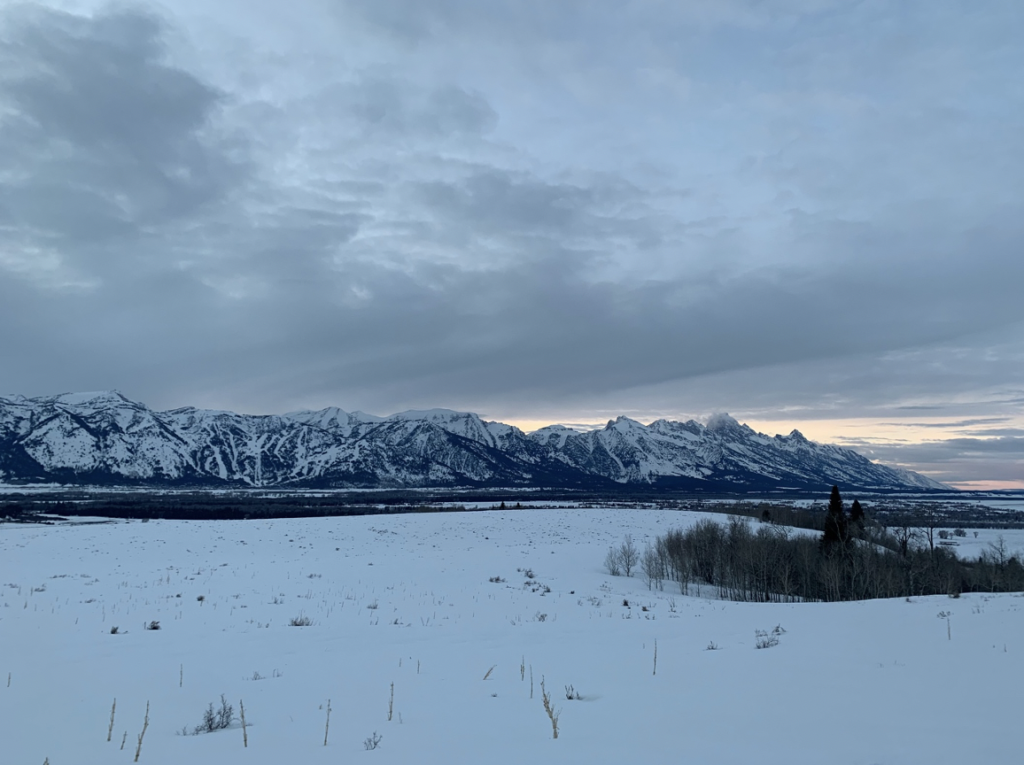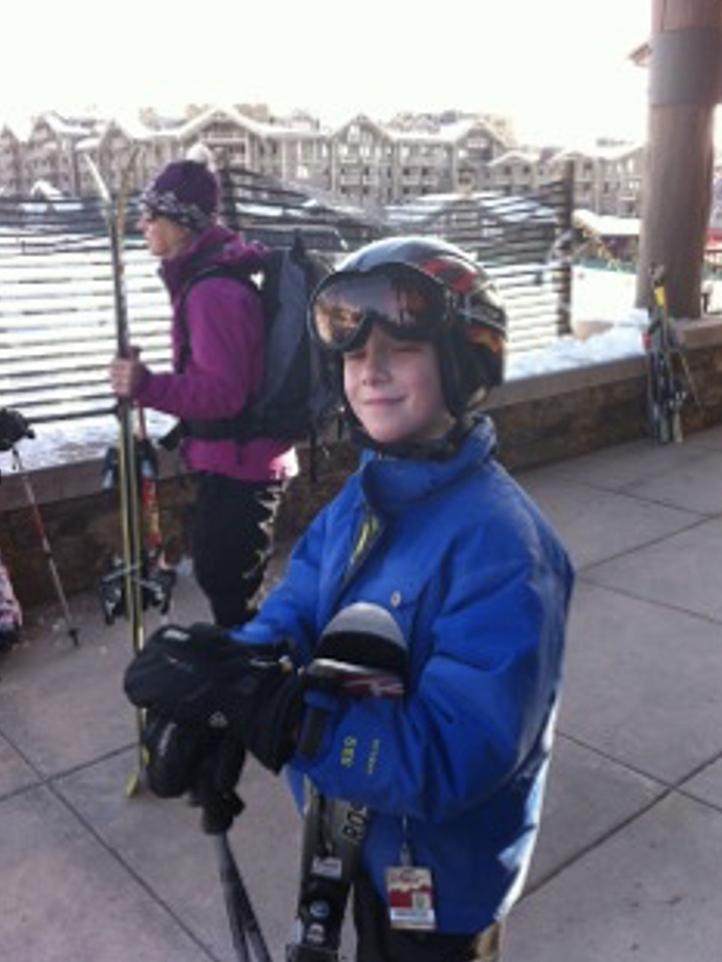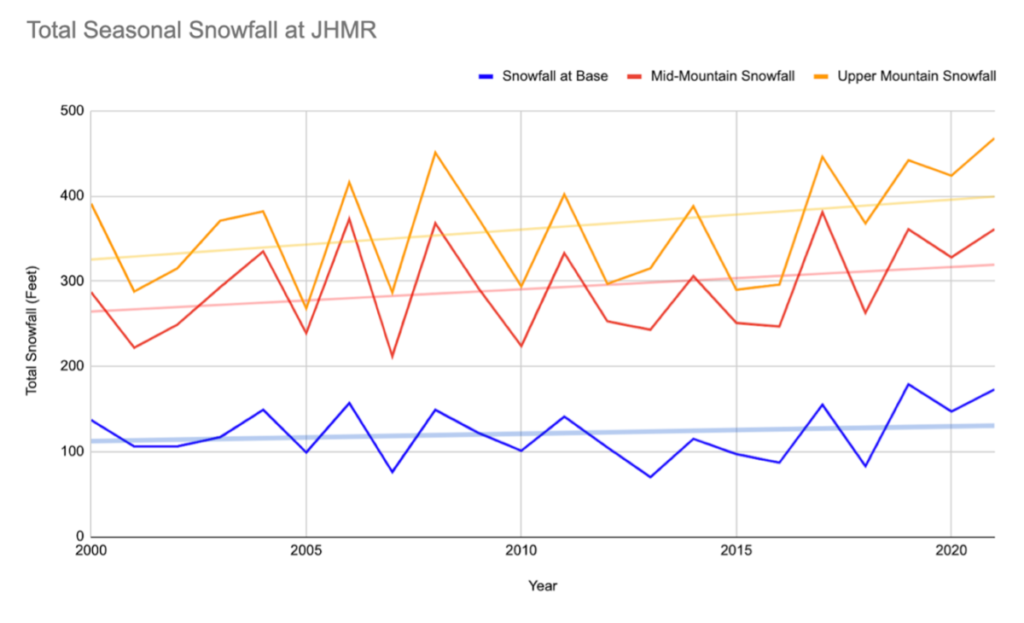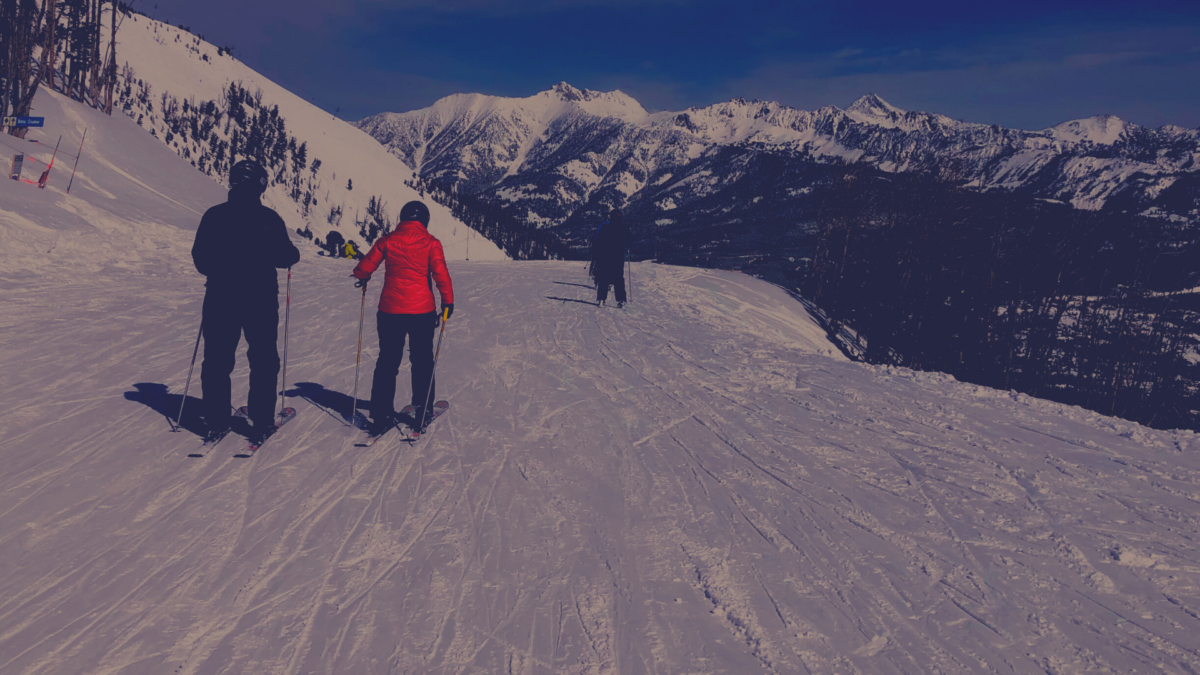
A Personal Mission
As a result of growing up in Jackson Hole, Wyoming, skiing has always been a vital aspect of my life. Before I even knew how to ride a bike, I found myself attempting to ski down the pee wee runs at the Jackson Hole Mountain Resort. By my upper years of elementary school, I was addicted to skiing and pushed myself to conquer the most difficult runs at Jackson Hole. To this day, I remember my first time dropping Corbet’s Couloir during winter break of the fourth grade. This sadly ended in a wipeout with a double ejection out of my skis and a slide down the whole couloir.

As I grew into my young adult years, my appreciation and attachment to skiing also grew. During my sophomore year of high school, an organization called Protect Our Winters, a nonprofit climate activist group, came to all the high schools in Jackson Hole and told a dark story of how climate change will destroy the sport of skiing by slowly bringing an end to snowfall. Fueled by my love for skiing, I took it upon myself to investigate the historic impact of climate change on the western ski industry with a specific emphasis on the mountain of Jackson Hole.
How is Snowfall Measured?
One of the hardest parts to thoroughly completing this study is the fact that snowfall measuring technology has historically been inaccurate. In a recent interview, Bruce Keller, a long-term mountain guide and employee at Jackson Hole Mountain Resort explained to me that up until the early 2000s, most ski resorts used a device called a snow gauge to measure daily snowfall. A snow gauge is essentially a yard stick that is planted in the snow. As snow falls, the snow gauge becomes further buried and the amount the gauge was buried becomes the recorded snowfall. This can be a grossly inaccurate way to measure snowfall because any form of wind can cause a measurement error of multiple inches. Furthermore, the consistent wind on mountains only allows a snow gauge to be used on specific low wind areas. As a result of this, snowfall on higher areas of mountains, where wind levels typically increase, are rarely included in snow gauge reports.
Mr. Keller explained that in the past two decades, larger mountains, including Jackson Hole, have integrated new measurement technologies in the form of sonar. While sonar measurements are not completely accurate, they are capable of measuring large areas of snowfall and therefore give data less influence by wind. As a result of the substantial difference in accuracies between modern and older snowfall technologies, only data collected with sonar technologies, which according to the National Resource and Conservation Service was not fully introduced at mainstream western ski resorts until the early 2000s, will be analyzed. While this does detract from research in the sense that a longer duration of climate change and snowfall is not being examined, it ensures that the basis of research is accurate and allows one to draw accurate conclusions. After examining the history of yearly snowfall patterns along with scientifically produced climate models, I concluded that climate change may be responsible for a decreasing monthly duration of snowfall along with an increase of snowfall during the mid-winter season.
Difference Between Weather and Climate Changes
When analyzing climate related issues, it is important to identify the difference between climate change and general weather patterns. According to the National Oceanic and Atmospheric Administration, climate change refers to the average day to day weather at a specific location over an extended period of time while weather refers to the short-term state of a specific atmosphere. In this scope of my research, I perceived the average change in snowfall across 20 years of ski seasons in Jackson Hole as climate changes. While specific seasonal trends are interesting when drawing overall conclusions, a high snowfall winter may result from weather patterns of above average snowfall. A long duration of data collection helps eliminate the impact of weather patterns and gives a more holistic picture of how a climate is behaving.
What Causes Snowfall Patterns?
Before analyzing the snowfall patterns at Jackson Hole, it was important to understand whether climate change was even the most likely culprit for the potential conclusions presented in snowfall patterns. The root of snowfall patterns stems from the combinations of ingredients that cause snow to form. As explained by a 2020 research article published by the National Snow and Ice Data center, snow can only form when the temperature of the atmosphere is at or below the point of freezing in conjunction with minimal air moisture. Furthermore, the temperature of the ground itself must be at or below freezing to see snow reach the surface. The actual amount of snowfall itself results from the hydrogen cycle. As author Tristan Kershaw, a climate change expert and professor at the University of Bath, explained in his 2017 book outlining climate change’s weather and urban environment impacts, climate change is leading to changes in the hydrogen cycle. The hydrogen cycle is the term used to describe the journey water molecules undergo when they evaporate from earth’s surface, rise to the atmosphere, and eventually condense and fall in the form of precipitation. Mr. Kershaw explained that the warmer temperatures resulting from the catalysts of global warming, such as increased solar radiation intensity (insolation), will lead to an increase in overall water evaporation and therefore more precipitation. Furthermore, warm air is able to hold more water which will lead to a larger volume of evaporated water being transported into the atmosphere.
How may Global Warming Impact Snowfall?
Mr. Kershaw’s conclusions about climate change’s influence on the hydrogen cycle allow one to draw interesting conclusions about the impact increases in global temperatures will have on snowfall. If climate change is impacting the hydrogen cycle as stated, one would expect to see a pattern of less snowfall during the shoulder seasons in Jackson Hole along with an increase of total snowfall during the colder middle seasons. This should occur because warming global temperatures will cause a pattern of fewer days where the temperature is below freezing during the months that lead up and conclude a typical season. Any precipitation that falls during these time periods should either come down as rain or evaporate before it reaches the earth’s surface. During the mid-winter seasons, where temperatures are still warming but usually stay below the point of freezing, the additional amount of condensing water should still freeze before it reaches the surface and appear in the form of snowfall.
What Does the Data from a Full Season Tell Us?
The snowfall trends in Jackson Hole analyzed over the past two decades agree with Mr. Kershaw’s conclusions about global warming’s impact on precipitation. The Bridger-Teton Avalanche Center analyzes snowfall every day of the season at Jackson Hole Mountain Resort. All collected data is categorized and published on a list that has records of daily total snowfall dating back to 1975. The graph below is a personal analysis of the total snowfall data published between the years of 2000-2021 by The Bridger-Teton Avalanche Center. It is important to note that the graph is only comparing the trend of total yearly snowfall during the typical ski season dates of late November to mid-April. Each line on the graph signifies a different elevation of snowfall at Jackson Hole Mountain Resort. As shown on the graph, areas of higher elevation typically receive a greater degree of snowfall. This occurs because the colder temperatures that coincide with higher elevation cause air to cool down and lose the water it was once holding. Due to the fact that the winter temperatures of high elevation areas do not often fall below freezing, nearly all precipitation will fall in the form of snow. When analyzing the respective yearly snowfall patterns at Jackson Hole Mountain resort, it is important to take note of the rising trend lines. The rising trend lines signify that the total yearly snowfall in Jackson Hole is seeing an overall increase. This supports the conclusion that the immediate future of Jackson Hole will be seeing an overall rise in snowfall as a result of climate change.

The physical data provided by The Bridger-Teton Avalanche Center summarizing total snowfall during the 2020/2021 season shows an 18’ increase in total base snowfall, a mid-mountain total snowfall increase of 34’, and an upper mountain total snowfall increase of 18’ from the 2000/2001 season. While on face value, this information adds to the argument that climate change is influencing snowfall patterns within the ski industry, it is important to notice the randomness of the yearly snowfall patterns. As shown on all three data series within the graph, the trend in snowfall patterns was not at all consistent. The entire 20-year data sample was full of numerous rises and dips of snowfall and a clear trend is difficult to find. For example, the 2016/2017 season, which is a mere 4 seasons before the end of the data set, shows some of the lowest recorded snowfall in the entire set. This allows one to make the argument that snowfall patterns may be completely random and do not have a strong correlation with climate change. When looking at outlying data such as the 2016/2017 season, it is important to remember the difference between climate change and weather variation. While the 2016/2017 season has an interesting snowfall level, it may be a result of weather patterns within that ski season and may not accurately show any true impacts of climate change.
What Does the Shoulder Season Data Tell Us?

The graph above analyzes the total recorded snowfall during the fall shoulder seasons between 2000 and 2020 (Remember, the ideas of global warming being tested state that there should be a decrease in shoulder season snowfall.) The spring shoulder seasons were not able to be graphed because the current data release system did provide information on snowfall changes within specific spring date ranges. Unlike the Total Seasonal Snowfall graph, the trendlines on the fall shoulder season graph do not follow a uniform pattern. The trendlines of the lower elevation recordings show a decrease in total snowfall over the past 20 years. This supports claims that warming temperatures in the shoulder seasons are leading to less snowfall. The highest elevation recording, however, showed an increase in total snowfall over the 20 years span. Even though one may use this information as an argument against the ideas of climate change’s impact on snowfall, it is important to take into account the temperature differences of the elevations. According to the temperature data released by the Bridger-Teton Avalanche Center, the average minimum temperature was more than a degree lower at the upper mountain snowfall recording location than the mid-mountain and base snowfall measuring locations. Furthermore, the average maximum temperature at the upper mountain snowfall measuring location was a degree lower than the mid-mountain snowfall measuring location and five degrees lower than the base snowfall measuring location. Even though there is no reasoning behind the snowfall patterns that is not open to scrutiny, the lower temperatures at the upper mountain measuring location could lead to the conclusion that climate change does not yet have a lasting impact on total snowfall at that elevation.
Beginning in the 2012/2013 season, the Jackson Hole Mountain Resort began to release data on what specific days experienced snowfall. According to On the Snow, a website that organizes data presented by ski mountains, the 2012/2013 season saw three days of snowfall in October, five days of snowfall in November, a steady stream of snowfall during the cold winter months, and three days of snowfall in April. The 2020/2021 season, however, saw no snowfall in October, two days of snowfall at the end of November, steady snowfall through February, eight days of snowfall in March, and two days of snowfall in April. While the total snowfall during the 2020/2021 season was higher than the 2012/2013 season, the snowfall in the 2020/2021 shoulder seasons was significantly smaller than the 2012/2013 shoulder seasons.
What do the Experts Think?
The argument that climate change is negatively impacting snowfall during the Jackson Hole shoulder seasons was further strengthened by a 2016 study published in the 29th volume of the Journal of Climate. The study, which focused on the mountainous regions of the western United States, analyzed yearly snowfall and rainfall trends over the past fifty years. One of the many conclusions of the study cites that spring and fall snowfall is on a rapid decline and snowmelt is gradually occurring earlier in the ski seasons. The study concluded that the decline of snowfall and increase in snowmelt is taking place because warming early winter and early spring temperatures are causing what would traditionally be spring and fall snowfall to come down in the form of rain. The study also concluded that the largest warming trends occurred in mountainous western areas with the historically coldest temperatures. Even though the warming trends have not yet negatively impacted total snowfall in these regions, it paints a dark and worrisome image for the future for the ski industry.
Conclusions and Takeaways from my Research
The studied snowfall patterns at Jackson Hole Mountain Resort mirrored professional conclusions detailing the impacts of climate change on snowfall. The upwards trends in yearly snowfall add to the conclusions about the immediate impacts of climate change on total snowfall. The shortening windows of snowfall discovered also add to conclusions about the impact of warming late fall and early spring months. If this pattern continues, the window of yearly snowfall will continue to decrease until the winters completely disappear. While my research does coincide with scientific conclusions about how climate change will impact snowfall, it was completed very prematurely for this particular climate topic. As shown in “Advancing the Science of Climate Change,” a book published by the National Research Council which details the most modern and accurate methods of climate research, to describe a change in a specific climate, multiple decades of research at the minimum must be compiled. In the case of my own research, I believed that analyzing accurate data over recent history would be more rewarding than backing up my claim with potentially flawed data. Even though my current findings are backed with the most accurate snowfall data available, the undesired timespan of the study does leave all my findings open to scrutiny. Furthermore, the window of time being analyzed made it difficult for me to compare more ski seasons to each other due to conflicts with season-to-season proximities. In the future, as a continuous compilation of more accurate data becomes available, I hope that another skiing enthusiast who is fueled by a love of the sport will continue to help me make others aware of this looming threat to the ski industry and make sure that people can still hit the slopes for years to come!!!!

Bibliography
Danco, James F., Anthony M. DeAngelis, Bryan K. Raney, and Anthony J. Broccoli.”Effects of a Warming Climate on Daily Snowfall Events in the NorthernHemisphere.” Journal of Climate 29, no. 17 (August 22, 2016): 6295-318. https://doi.org/10.1175/JCLI-D-15-0687.1
Groisman, Pavel Ya., and David R. Easterling. “Variability and Trends of Total Precipitation and Snowfall over the United States and Canada.” Journal of Climate 7, no. 1 (1994): 184-205. Accessed May 6, 2021. http://www.jstor.org/stable/26197835
“Historical Weather Data.” Bridger-Teton Avalanche Center. Accessed May 07, 2021. https://www.jhavalanche.org/.
“Jackson Hole Snow History.” On the Snow. Accessed May 5, 2021.https://www.onthesnow.com/wyoming/jackson-hole/historical-snowfall.html?&y=2019.
Keller, Bruce. Telephone interview by the author. Atlanta, GA. May 5, 2021.
Kershaw, Tristan. Climate Change Resilience in the Urban Environment. IOP Publishing, 2017. PDF book.
Knowles, Noah, Michael D. Dettinger, and Daniel R. Cayan. “Trends in Snowfallversus Rainfall in the Western United States.” Journal of Climate 19, no.18 (September 15, 2006): 4545-59. https://doi.org/10.1175/JCLI3850.1.
National Research Council. Advancing the Science of Climate Change. N.p.National Academies Press, 2010.
National Snow and Ice Data Center. “How Snow Forms.” National Snow and Ice DataCenter. Last modified January 10, 2020. Accessed May 7, 2021. https://nsidc.org/cryosphere/snow/science/formation.html
O’Gorman, Paul A. “Contrasting Responses of Mean and Extreme Snowfall to ClimateChange.” Nature 512, no. 7515 (August 2014): 416-18. https://doi.org/10.1038/nature13625.
“Program Overview.” NRCS National Water and Climate Center | Home. Accessed May 07, 2021. https://www.wcc.nrcs.usda.gov/about/prog_overview.html#:~:text=In 1977, the automated Snow,(SNOTEL) system was introduced.
US Department of Commerce, National Oceanic and Atmospheric Administration. “What Is the Difference between Weather and Climate?” NOAA’s National Ocean Service. October 02, 2009. Accessed May 14, 2021. https://oceanservice.noaa.gov/facts/weather_climate.html.
“Utah Daily Snow.” OpenSnow. Accessed May 5, 2021. https://opensnow.com/dailysnow/utah
